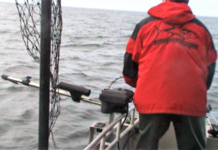
NOAA’s Deep Discoverer remotely operated vehicle explores during a 2013 expedition to investigate the U.S. Atlantic canyons. Image courtesy of the NOAA Okeanos Explorer Program.
Did You Know?
In 2013, NOAA’s Office of Ocean Exploration and Research (OER) unveiled a new ROV, the Deep Discoverer, or “D2.”
Operated from NOAA Ship Okeanos Explorer, D2 is one of the few ROVs in operation capable of diving to a depth of 6,000 meters, allowing scientists to access the vast majority of the seafloor. With this vehicle, OER joins an elite group that can reach all but the deepest of the world’s ocean trenches.
Remotely operated vehicles, or ROVs, allow us to explore the ocean without actually being in the ocean.
These underwater robots are controlled by a person typically on a surface vessel, using a joystick in a similar way that you would play a video game. A group of cables, or tether, connects the ROV to the ship, sending electrical signals back and forth between the operator and the vehicle.
Most ROVs are equipped with at least a still camera, video camera, and lights, meaning that they can transit images and video back to the ship. Additional equipment, such as a manipulator or cutting arm, water samplers, and instruments that measure parameters like water clarity and temperature, may also be added to vehicles to allow for sample collection.
First developed for industrial purposes, such as internal and external inspections of underwater pipelines and the structural testing of offshore platforms, ROVs are now used for many applications, many of them scientific. They have proven extremely valuable in ocean exploration, and are also used for educational programs at aquaria and to link to scientific expeditions live via the Internet.
ROVs range in size from that of a small computer to a small truck. The larger ones are very heavy and need other equipment such as a winch to put them over the side of a ship and into the water.
While using ROVs eliminates the “human presence” in the water, in most cases, ROV operations are simpler and safer to conduct than any type of occupied-submersible or diving operation because operators can stay safe (and dry!) on ship decks.
For More Information:
Tools of Exploration: ROV (pdf, 1.3 Mb)
NOAA Ship Okeanos Explorer 2013 ROV Shakedown and Field Trials in the U.S. Atlantic Canyons
Sign up for the Ocean Explorer Email Update List.














